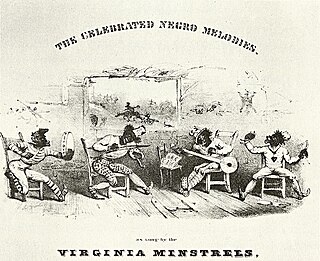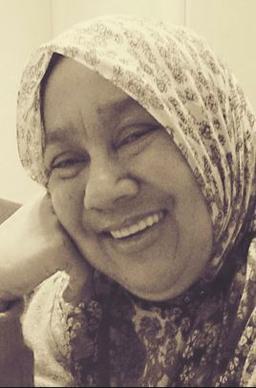
Blackface is the practice of performers using burnt cork or theatrical makeup to portray a caricature of black people on stage or in entertainment. Scholarship on the origins or definition of blackface vary with some taking a global perspective that includes European culture and Western colonialism. Scholars with this wider view may date the practice of blackface to as early as Medieval Europe's mystery plays when bitumen and coal were used to darken the skin of white performers portraying demons, devils, and damned souls. Still others date the practice to English Renaissance theatre, in works such as William Shakespeare's Othello.

The minstrel show, also called minstrelsy, was an American form of theater developed in the early 19th century. The shows were performed by mostly white actors wearing blackface makeup for the purpose of comically portraying racial stereotypes of African Americans. There were also some African-American performers and black-only minstrel groups that formed and toured. Minstrel shows stereotyped blacks as dimwitted, lazy, buffoonish, cowardly, superstitious, and happy-go-lucky. Each show consisted of comic skits, variety acts, dancing, and music performances that depicted people specifically of African descent.

Coloureds refers to members of multiracial ethnic communities in South Africa, Namibia and to a lesser extent, Zimbabwe and Zambia who have ancestry from African, European, and Asian people. The intermixing of different races began in the Cape province of South Africa, with European settlers intermixing with the indigenous Khoi tribes, and Asian slaves of the region. Later various other European nationals also contributed to the growing mixed race people, who would later be officially classified as coloured by the apartheid government in the 1950s.

Cape Malays also known as Cape Muslims or Malays, are a Muslim community or ethnic group in South Africa. They are the descendants of enslaved and free Muslims from different parts of the world, specifically Indonesia and other Asian countries, who lived at the Cape during Dutch and British rule.

The Trinidad and Tobago Carnival is an annual event held on the Monday and Tuesday before Ash Wednesday in Trinidad and Tobago. This event is well known for participants' colorful costumes and exuberant celebrations. There are numerous cultural events such as "band launch" fetes running in the lead up to the street parade on Carnival Monday and Tuesday. Traditionally, the festival is associated with calypso music, developed by enslaved West and Central Africans in 17th century Trinidad; however, Soca music has begun to replace calypso as the more popular musical genre for Carnival. Costume, stick-fighting, limbo, and steelpan competitions are important components of the festival.

The Carnival of Brazil is an annual festival held the Friday afternoon before Ash Wednesday at noon, which marks the beginning of Lent, the forty-day period before Easter. During Lent, Roman Catholics and some other Christians traditionally abstained from the consumption of meat and poultry, hence the term "carnival", from carnelevare, "to remove meat."

The carnival in Colombia was introduced by the Spaniards. The Colombian carnival has incorporated elements from European culture, and has managed to syncretise, or re-interpret, traditions that belonged to the African and Amerindian cultures of Colombia. There is documentary evidence that the carnival existed in Colombia in the 17th century and had already caused concern to the colonial authorities, who censored the celebrations, especially in the main centers of power such as Cartagena, Bogotá and Popayán. The carnival, therefore, continued its evolution and re-interpretation in the small and at that time unimportant towns where celebrations did not offend the ruling elites. The result was the uninterrupted celebration of carnival festivals in Barranquilla, and other villages along the lower Magdalena River in northern Colombia, and in Pasto, Nariño in the south of the country. In modern times, there have been attempts to introduce the carnival in the capital, Bogotá, in the early 20th century, but it has always failed to gain the approval of authorities. The Bogotá Carnival has had to wait until the 21st century to be resurrected, this time, by the authorities of the city. Colombia is recognized by its large variety of festivals, carnivals and fairs. Most towns have their own, ranging from those celebrating coffee to the ones held in honor of the town's Saint feast. The common characteristics of the festivals are the nomination of a beauty Queen and the setting up of public dance floor.

The Bo-Kaap is an area of Cape Town, South Africa formerly known as the Malay Quarter. It is a former racially segregated area, situated on the slopes of Signal Hill above the city centre and is a historical centre of Cape Malay culture in Cape Town. The Nurul Islam Mosque, established in 1844, is located in the area.

Laurika Rauch, is a South African singer who performs in both Afrikaans and English. She had a hit single in 1979 with Kinders van die Wind, written by Koos du Plessis. The song featured prominently in the Afrikaans television series "Phoenix & Kie" in the late seventies.
Cape jazz is a genre of jazz that is performed in the very southern part of Africa, the name being a reference to Cape Town, South Africa. Some writers say that Cape jazz began to emerge in 1959 with the formation of The Jazz Epistles, many of whom were from Cape Town, including Abdullah Ibrahim, then known as Dollar Brand. Cape jazz is similar to the popular music style known as marabi, though more improvisational in character. Where marabi is a piano jazz style, Cape jazz in the beginning featured instruments that can be carried in a street parade, such as brass instruments, banjos, guitars and percussion instruments.
Chanté mas and Lapo kabrit is a form of Carnival music of Dominica. It is performed by masquerading partygoers in a two-day parade, with a lead vocalist (chantwèl), who is followed by the responsorial chorus (lavwa), with drummers and dancers dancing backwards in front of the drummer on a tambou lélé. The Carnival has African and French roots and is otherwise known as Mas Dominik, the most original Carnival in the Caribbean.
Taliep Petersen was a South African singer, composer and director of a number of popular musicals. He worked most notably with David Kramer, with whom he won an Olivier Award.

Manenberg is a township of Cape Town, South Africa, that was created by the apartheid government for low-income Coloured families in the Cape Flats in 1966 as a result of the forced removal campaign by the National Party. It has an estimated population of 52,000 residents. The area consists of rows of semi-detached houses and project-like flats, known as "korre". The township is located about 20 km away from the city centre of Cape Town. It is separated from neighbouring Nyanga and Gugulethu townships by a railway line and Nyanga Junction to the east and from Hanover Park by the Sand Industria industrial park to the west and Heideveld to the north. The northern part of Manenberg,(closest to Phillipi and Edith Stevens wetland nature reserve)is known as Sherwood Park ,here, in the past live many wealthy people of both Christian and Muslims descent,sadly all this changed.The middle and lower class live in Manenberg.Poverty, unemployment,lack of education and motivation,coupled with drug abuse/addiction,gang activities ,social injustice and racial profiling are some of the major issues people in Manenberg suffer under.

The Ghoema Music Awards is an annual South African award ceremony that recognises outstanding achievement in the Afrikaans music industry. It is the only independent music award ceremony of its kind in South Africa. The event was established in 2012 and the awards are presented by the Ghoema Trust. The ceremony is held in March every year, and contenders are judged on performances made in the previous year. The show broadcasts on KykNET.

Faldela Williams was a South African cook and cookbook writer whose books inspired generations of cooks after her to preserve the culinary heritage of South Africa's Cape Malay people.
Hilton Schilder is a South African musician, well known in the genre of Cape jazz.

A koesister or koe'sister is a traditional Cape Malay pastry often described as a spicy dumpling with a cake-like texture, finished off with a sprinkling of coconut.

The following outline is provided as an overview of and topical guide to Cape Town:
Daniel Ferdinand (Danie) Bosman was a South African Composer who mainly composed Afrikaans music. Although his first language was English, he composed Afrikaans songs like "Boereseun" and "In die skadu van ou Tafelberg".


















